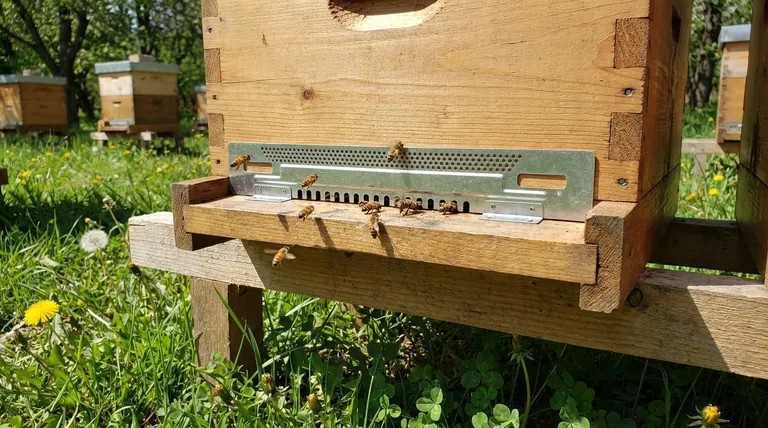For a standard beehive, the primary entrance is almost always located at the very bottom, integrated into the hive's bottom board. However, beekeepers frequently modify this standard setup by adding secondary entrances higher up on the hive to solve specific operational challenges related to ventilation and efficiency.
The location and number of hive entrances are not arbitrary; they are strategic decisions a beekeeper makes to manage hive defensibility, forager traffic, and internal climate control.

The Standard Bottom Entrance: A Foundational Design
The default configuration for nearly all modern beehives is a single entrance at the base. This design mimics the natural tendencies of wild honeybee colonies and serves several core functions for the hive.
The Role of the Bottom Board
The entrance is a key feature of the bottom board, the floor of the hive. This single point of entry and exit serves as the primary gateway for all bee traffic, including foragers leaving to collect resources and guard bees monitoring for threats.
Solid vs. Screened Bottoms
While older hives used solid wood bottom boards, many modern designs feature a screened bottom. This allows for increased ventilation and helps with monitoring and managing Varroa mite populations, as the mites may fall through the screen and out of the hive.
Why Beekeepers Create Additional Entrances
A single bottom entrance can become a bottleneck in a strong, productive colony. Experienced beekeepers often add upper entrances to optimize hive function, particularly during periods of high activity.
Improving Forager Efficiency
During a heavy nectar flow, honey supers are placed on top of the brood boxes. An upper entrance allows returning foragers to fly directly into the supers, bypassing the congestion of the lower brood nest and depositing their nectar more quickly.
Enhancing Ventilation
Bees must dehydrate nectar to turn it into honey, a process that releases a significant amount of moisture. An upper entrance creates a "chimney effect," improving airflow that vents this warm, moist air out of the hive and helps regulate the internal temperature.
Common Modification Methods
Creating an upper entrance is straightforward. Beekeepers may drill a simple 1-inch hole in a honey super, slightly offset or stagger the boxes to create a small gap, or insert a purpose-built shim with a notch that provides a dedicated entrance.
Understanding the Trade-offs
While multiple entrances can offer benefits, they also introduce challenges that must be carefully managed. This strategic choice is not without consequences.
The Security Dilemma
Every entrance is a potential security vulnerability. A single, small entrance is easy for a colony to defend against pests like wasps or robbing bees from other hives. Multiple entrances require more guard bees, potentially straining the resources of a smaller or weaker colony.
Managing for the Season
Upper entrances are primarily a tool for the productive season. In winter, they can create an undesirable draft and make it harder for the colony to maintain the temperature of its cluster. Most beekeepers close off upper entrances before winter begins.
Making the Right Choice for Your Goal
The correct entrance strategy depends entirely on the current state of your colony and your environmental conditions.
- If your primary focus is establishing a new or weak colony: Use a single, reduced bottom entrance to maximize its ability to defend itself.
- If your primary focus is maximizing honey production in a strong colony: Add an upper entrance near the honey supers to improve forager efficiency and ventilation.
- If your primary focus is overwintering in a cold climate: Ensure all upper entrances are sealed and that the main bottom entrance is reduced to prevent drafts and deter mice.
Ultimately, managing your hive's entrances is a key lever for proactively influencing its health, security, and productivity.
Summary Table:
| Entrance Type | Primary Function | Best Use Case |
|---|---|---|
| Standard Bottom Entrance | Main entry/exit point, hive defense | All hives, especially new or weak colonies |
| Upper Entrance | Improves forager efficiency & ventilation | Strong colonies during honey flow |
| Screened Bottom | Enhances ventilation & mite control | Integrated with the bottom entrance for hive health |
Ready to equip your apiary with the right supplies for optimal hive management?
At HONESTBEE, we supply commercial apiaries and beekeeping equipment distributors with high-quality, wholesale-focused beekeeping supplies. From durable bottom boards to equipment for creating effective upper entrances, we provide the tools you need to enhance your hive's productivity and health.
Contact our expert team today to discuss your specific needs and streamline your operations.
Visual Guide

Related Products
- Beehive Entrance Reducer Guardian Metal Hive Entrance for Bees
- Multi-Functional Sliding Hive Entrance for Beekeeping
- Multi-Functional Rotary Hive Entrance Disc for Beekeeping
- Beehive Entrance Discs Plastic Bee Entrance Disc for Bee Hives
- Professional Hive Front Entrance Bee Feeder
People Also Ask
- What should be done after transferring frames to the new hive? Essential Steps for a Secure Colony
- How can a Langstroth hive entrance be adjusted? Mimic Natural Bee Preferences for a Healthier Hive
- What are the two functions of the Entrance Reducer? Master Hive Defense and Safe Transport
- What are the different entrance sizes for an 8 or 10-frame Langstroth hive? A Guide to Seasonal Management
- What are the different types of entrance reducers available? A Guide to Protecting Your Hive

















